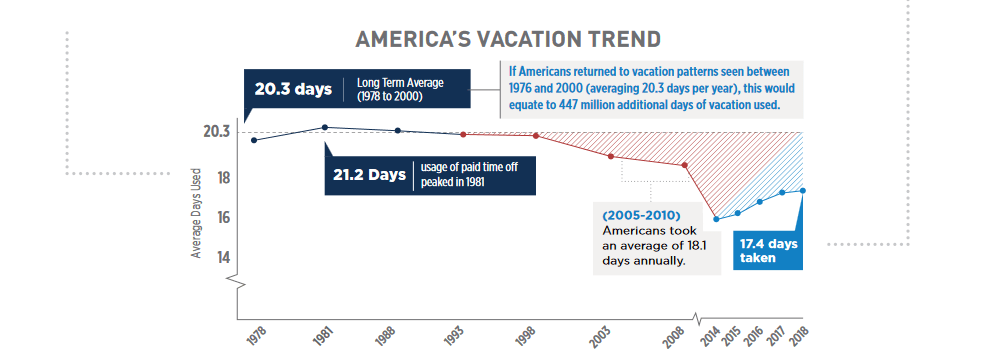April 23, 2024
What is Garden Leave? (Aka Gardening Leave)
Key Takeaways:* Garden Leave, or Gardening Leave, is when an employee leaves their job and is asked to stay a...

A lot of jobs still, to this day, don’t offer adequate PTO. It’s not even a legal requirement in the US, which is a big reason why burnout is so widespread in today’s workforce.
But that’s not the only reason. Even employees who have the option to take PTO don’t always take advantage of it. A large number of people don’t use their vacation days, for a number of reasons.
As an employer, that might seem like a good thing. But it’s not. It leads to bigger problems down the road, despite the perception that you’re getting more productivity up front.
Read on to learn more about why these employees aren’t taking all their paid time off, why it matters, and what you can do about it.
The US Travel Association’s Paid Time Off Trends Survey shows that 55% of American workers don’t take all the PTO available to them.
In the last 20 years, the number of PTO days taken has been dropping. From 1978 to 2000, the average number of vacation days taken each year was 20.3 days. Since then, it’s fallen to as low as 16 days per year on average.
Across the entire workforce, this equates to 768 million unused vacation days – 447 million more than the average number of unused days per year between 1978 and 2000.
Despite the number of vacation days taken having dropped, the amount of PTO available to employees is rising every year, creating this disparity.
It’s also worth noting that Americans use an average of 9 vacation days per year (of the roughly 17 vacation days taken) to travel. So nearly half of the time people take paid vacation is not actually spent on a proper vacation.

So if the days are there and available for workers, why aren’t they being taken?
There could be a number of reasons why. Let’s take a look at some.
Many workers simply have too much on their plate to justify taking time off.
Though technically the PTO days are there, available, and well within their rights to take, doing so might mean they fall even further behind on their work, resulting in an ever-growing workload.
So employees end up working for a long period of time without taking a break, for fear of what’s going to be waiting for them when they return to the office.
A lot of companies offer paid time off, but there’s a (generally unspoken) vibe about employees who regularly take vacation days.
These people are seen as not being so committed to the company, and letting the team down when they’re not around. On the other hand, employees who don’t take leave are seen as being extra dedicated, hard-working, and sacrificing their vacation time (and wellbeing) for the good of the team.
People might also feel insecure about the prospect of going away from work and letting the boss see that the business can run without them.
They’re going to be replaced, if temporarily, while they’re on leave. So the fear is that they could easily be replaced permanently, perhaps by a person who doesn’t take as much leave.
It’s basically an extension of the first two reasons. A high workload and negative view towards people who take leave can lead to these people thinking that they just can’t afford to take time off, for fear of what might happen to their job security.
Some people just put off taking their vacation days because they want to save up. This is common in workplaces where the number of PTO days is quite low, and rolls over from one year to the next.
For example, you have 10 PTO days per year. The employee might want to save these days, until eventually they have enough to take a long vacation (longer than 2 weeks).
Or, they might simply be afraid of using the few vacation days they have, and then not having any available should they need/want them.
The result is that people work a long time without taking a break – which can prove to be problematic.
In some companies, you have the option to get your PTO days paid out, instead of actually taking a day off.
In this case, you’re going to find a lot of employees who prefer this, as it essentially constitutes a bonus on top of their regular pay.
And while the company might see this as a plus – they don’t lose out on any productive days since the employee doesn’t actually take any time off. But, like above, it ends up being problematic in the long term.
Related Article: Employee Burnout: Signs to Watch For, and How to Prevent It
So why is it important that your employees take all their paid time off?
Paid time off is not just a token benefit, to make the business look good for potential hires. It helps workers stay rested, refreshed, healthy and happy.
That results in higher performance at work, a positive attitude towards work (which spreads throughout the company), and less risk of absenteeism or burnout.
An employer might think they’re losing out on productivity when someone takes time off. They might think that another employee, who comes into work every day without ever taking leave, is doing more for the company.
But in the long run, it’s more likely that the second employee will get sick, unhappy, and that their performance will drop due to overwork.
Long-term, you’re going to see better performance and more productivity out of the employees who regularly take breaks to recharge their batteries. These employees are also likely to spend longer with the company, meaning less turnover, which is a huge cost to the business.
We all need a break, at least every now and then. We have our own lives, families, and priorities outside of work to consider. Working 5 days a week, week in week out, doesn’t give us enough time to build a positive work-life balance.
Further Reading: The Best Free Leave Management Software for Growing Startups
As a business owner or manager, you should want to increase the number of PTO days taken by your employees.
You may need to replace these productive hours in the short term, but long-term it’s going to result in a higher standard of work, happier employees, lower turnover and a more positive work environment.
Here are some ways to get people to take more of the vacation time available to them.
Everything starts with the culture you set.
If you treat it as a negative when someone asks for time off, you’re setting the culture that you don’t really want them taking their vacation time.
But if you create an understanding amongst employees that vacation time is there to be used, and is actually encouraged, they’ll have less hesitation about booking time off every now and then.
You can go even further and follow up with employees who have neglected to take vacation time, whether that might be due to company culture, workload, or simply not getting around to it. With Flamingo, for example, you might want to bring up your team’s leave report every month and check up on the employees who have gone a long time without taking any time off.
You want to consistently check up on your employees and what they have on their plate. While you obviously want to get as much as possible out of each employee, you don’t want it to get out of hand.
Always assess whether the work assigned to someone is getting to be too much. Especially consider the volume long-term – someone might be ok to take on a big workload in a short time, but if they’re constantly under the weight of too much work, it can get to be a problem.
You might also need to consider if you’re offering enough paid time off in the first place.
If you’re only offering a small amount – less than the average number of vacation days – a lot of employees will end up stockpiling their vacation days and rarely actually taking time off.
You might also want to think about offering unlimited PTO – a kind of leave policy that is not literally unlimited, but offers the flexibility to employees that time off will almost always be available should they need it.
Related: Key Unlimited PTO Statistics to know in 2024.
Finally, if people are cashing out their leave instead of taking it, you may want to think about paying your employees more.
While you might think you can’t afford this, consider the cost of underpaying your staff. First of all, through turnover – the estimated cost of replacing an employee is around 1.5-2 times their salary. Or even more for high-level employees or those in technical positions.
Then there’s the lost productivity, from employees who aren’t at their best because of a poor standard of living. US businesses lose $150 billion yearly due to lost productivity from employees who work too much without taking the time off they need to stay healthy and happy.
It’s these kinds of equations you need to understand if you’re to run a successful business. Pinching pennies in the short term does not always work out better in the long run.
The cost of replacing someone is around 1.5-2 times their salary – more for high-level or technical positions.
Modern businesses are increasingly catching on to the value of their employees actually taking all their paid time off. Yet some businesses, with rising salaries and operating costs, still see this as an area that they can’t afford to loosen up on.
Realistically, a business will be better off and get more productive hours out of employees if they are allowed to take regular vacation time. Their employees will be happier, healthier, contribute to a positive and more productive working environment, and stay with the company longer.
Take a look at your business and see if you recognize any of the signs mentioned above that your team members may be hesitant to take leave, and work on changing your company culture so that employees feel safe to take all the time off available to them.
Flamingo makes managing your team’s paid time off a breeze.